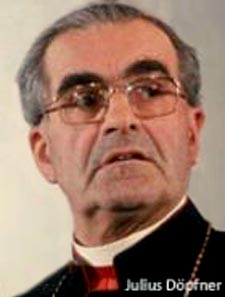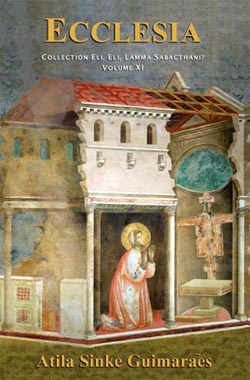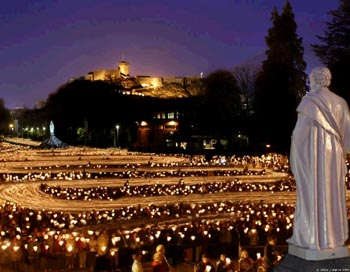 |
Consequences of Vatican II
When Love for the Church Disappears...
Lyle J. Arnold, Jr.
In Chapter IV of Atila Guimarães’ new book Ecclesia, Cardinal Julius Döpfner, one of the four Moderators of Vatican II, explains why he welcomes the introduction of the critical spirit in the Church:

Cardinal Dopfner promotes criticism of the Church as healthy |
"Until some time ago, many of us had a completely artificial, blind love for the Church. I remember, for example, some papal ceremonies before 1933 ... had an atmosphere in which the Holy Father, the Supreme Head of the Church, stood before us as one who sustains and protects the whole Church without the least shadow of criticism.
“Undoubtedly there was a certain romanticism linked to this at times. We tended to assume an irately apologetic attitude if anyone said something against the Church. We considered acknowledging anything negative in the Church as a participation in disavowing Christ, who is her Lord ...
“Then, at the Council, the Church herself began to exercise self-criticism ... She made a confession regarding her own conduct in the past ... The Pope came to be criticized with the same naturalness as the parish priest or classroom teacher. At times one has the impression that one should be ashamed of the Church. … It is necessary to keep our eyes on the end toward which this evolution is heading. It makes no sense trying to return to a blind love … for the Church" (1).
The Cardinal's use of the term "evolution" is quite fitting, because evolution's theory has it that change takes place in genetic material, i.e. in essence. Hence, over time, inorganic matter changed into bacteria, and bacteria into animals, and animals into men. Or, simply stated, a hydrogen particle evolved into man.
There is one point in which Dopfner's statement is correct: it is that for a long time affection was felt for the Church, but then it stopped. Something changed. At the Council the Church instead began a "confession" of her past, a self-critique because of her supposed sins, and Catholics were encouraged to engage in the same spirit of critique.
Chapter IV of Ecclesia is titled "The Sinning Church." It describes the many sins the progressivists imagine the Church is guilty of: the sin of power, the sin of an immutable moral teaching, the sin of responsibility for “Christians” being divided, the sin of having sacrality, grandeur, and riches. But they don’t stop there.
Since the Church supposedly sins, she must purge herself of this sin by submitting to a continuous reform. Hence the formula Ecclesia semper reformanda (the Church always in need of reform). The semper (always) is expressive: there would be nothing fixed in the Church. It would be, therefore, a Church on an incessant, evolving pilgrimage. Such is a simple recap of Chapter IV, "The Sinning Church."
The nature of the Church does not change
Progressivism has evolved into a kind of catatonic stupor. The notion of a sinning Church is absurd on its face, and grossly violates the law of identity according to which everything in existence has an immutable nature. The nature of the Church is clearly defined. Here are a few characteristics of the nature of the Church and their negation by Progressivism.

Ecclesia exposes the ‘Sinning Church’. More |
Item: The founding of the Church, while completed at Pentecost, had her birth when the centurion Longinus pierced the side of Christ, releasing blood and water. The blood running down his lance touched the eyes of Longinus, who was partially blind, and cured him. He is now St. Longinus. St. John Chrysostom interpreted that the blood to signify the Holy Eucharist, and the water Baptism. From these two Sacraments the Church was born. (3)
The response of Progressivism: This Church nevertheless is a sinner.
Item: The Church is defined as "the Kingdom of God on earth," with a mark of the Church being its sanctity, while a property of the Church is its holiness. (4)
The response of Progressivism: This Church nevertheless is a sinner.
Item: "The Church is the continuation and the prolongation of the Incarnate Word.'"
The response of Progressivism: this Church nevertheless is a sinner.
Item: St. Paul, writing to St. Timothy, stated that the Church is "the pillar and ground of the truth." (1 Tim. 3:15)
The response of Progressivism: St. Paul's words notwithstanding, the Church is a sinner.
Criticism replaces affection
I once heard the sermon of a pious and enlightened priest where he compared the mentalities of Catholics to Protestants. He used the term dead faith to describe the mentality of Protestants. The primary reason it is dead, said this priest, is because they lacked affection.
To state that the One, Holy, Catholic and Apostolic Roman Church is a sinner is so obnoxious, it defies the imagination. Yet throughout his latest work Ecclesia, Guimarães demonstrates this new progressivist attitude of criticism of the Church. Criticism has replaced affection. Page after page of this criticism brought to mind a book I had read immediately before Vatican II began.
The protagonist in the story, Dan England, is an aging Catholic bachelor, who is filled with affection for the Church, which spills over into his everyday conversations and lays the groundwork for the conversion of others. He doesn't enter into the fields of theology or philosophy, but his dictum is like a collage of love. In the following short excerpt from the book, the reader can compare the new doctrines of the progressivists, whose heart and soul reek of criticism, to the affection of yesterday that the simple man had for the Church.
In this scene, Dan’s friend, Doris, a skeptic, asks him to explain the Church. He replies:

Thousands of the faithful in a candlelight procession at Lourdes showing their love for Our Lady and the Catholic Church |
"The Church to me is all important things everywhere. It is authority and guidance. It is love and inspiration. It is hope and assurance. It is God the Father, God the Son, and God the Holy Ghost. It is Our Lady and St. Joseph. It is St. Peter and Pius XII. It is the Bishop and the pastor. It is the catechism and it is our mother leaning over the crib teaching us our evening prayers. It is the cathedral at Chartres and the cross-tipped hut on Ulithi. It is the martyrs in the Coliseum and the martyrs in Uganda, the martyrs at Tyburn and the martyrs at Nagasaki. It is the wrinkled old nun and the eager-eyed postulant. …
“It is the six o'clock Mass with its handful of unknown saints at the communion rail in the gray dark and it is pontifical High Mass with its crowds and glowing grandeur in St. Peter's. It is the candle-starred procession after evening Benediction in St. Patrick's and the Rosary, the night before the burial, at a stuccoed funeral parlor in Los Angeles. It is El Greco's soaring Assumption in Toledo and it is the primitive pink and blue angels on a mission altar in Peru. ...”
On and on he goes, describing the processions, the acts of charity of the Sisters, the mothers who pray for their sons gone astray, the saints and the simple faithful with their pious customs. Finally, he ends that long and poetic litany:
“It is the door through which I entered into the Faith and the Door through which I shall leave, please God, for eternity." (5)
His description is a litany of love for the Holy Church. Dan England's brand of affection was common before Vatican II. His words could melt hearts of stone. He obviously is not a catechist. He attracted people to the Faith through a passionate, yet natural, inspiration, because of his admiration and over-brimming affection for his Church.
I'll let the reader decide what effect Cardinal Dopfner's (et al) new spirit of criticism has on people. For me, it proves that the heresy of Progressivism has twisted the very nature of the Church. Its overall mentality is not affection but hatred, and the ultimate aim of their march through the swampy waters of error is the destruction of the perfect and immutable Holy Catholic Church. (6)
1. Volume XI in the Collection Eli, Eli, Lamma Sabacthani? by Atila S. Guimaraes, Los Angeles: TIA, 2009, p. 202 Available here.
2. Cf. The Laws of Thought and the Heresy of Progressivism," posted on Tradition in Action on 8-3-07.
3. The Catecheses, 3, 13-19, SC 50, 174-5.
4. Parente, Piolanti and Garofalo, Dictionary of Dogmatic Theology, Milwaukee: The Bruce Pub. Co, pp. 48, 174, 49.
5. Myles Connolly, Dan England and the Noonday Devil, Milwaukee: The Bruce Pub/Co, 1951.
6. Cf. Animus Delendi I(Desire to Destroy – I,) and Animus Delendi – II, by Atila S. Guimaraes. Available through Tradition in Action.

Posted August 3, 2009

Related Topics of Interest
 The Pact of Metz The Pact of Metz
 Examining the Mystery of God’s Church Examining the Mystery of God’s Church
 The Laws of Thought and the Heresy of Progressivism The Laws of Thought and the Heresy of Progressivism
 The Growing Rejection of Vatican II The Growing Rejection of Vatican II
 Question & Answers about the Collection: Elli, Eli, Lamma Sabacthani Question & Answers about the Collection: Elli, Eli, Lamma Sabacthani
 Revolution and Counter-Revolution in the Tendencies Revolution and Counter-Revolution in the Tendencies

Related Works of Interest
|
|
Vatican II | Hot Topics | Home | Books | CDs | Search | Contact Us | Donate

© 2002-
Tradition in Action, Inc. All Rights Reserved
|
 |
|